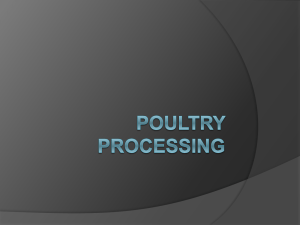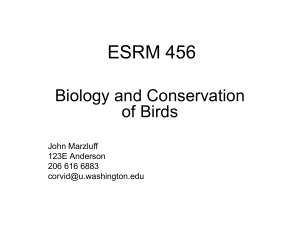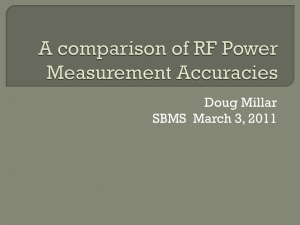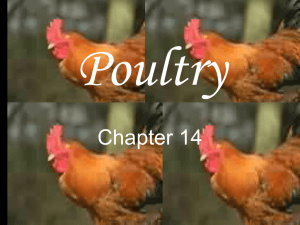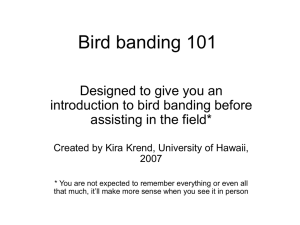Home Poultry Processing, Part Two
advertisement
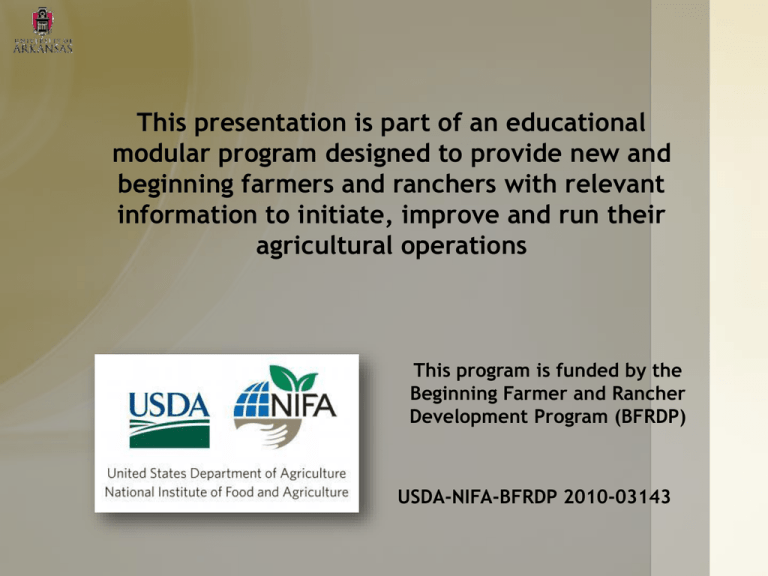
This presentation is part of an educational modular program designed to provide new and beginning farmers and ranchers with relevant information to initiate, improve and run their agricultural operations This program is funded by the Beginning Farmer and Rancher Development Program (BFRDP) USDA-NIFA-BFRDP 2010-03143 Home Processing of Poultry Part 2 This project is partly sponsored by USDA-NIFA-BFRDP 2010-03143. • There are 3 different steps in the processing procedure: 1. Killing, scalding, picking, singeing 2. Eviscerating (removal of internal organs) and washing 3. Chilling and packaging • To reduce possibilities of contamination, process must be done in this order • Step 1 should take place in a separate room or outside of the room where steps 2 and 3 take place “Dirty zone” • Killing • Scalding • Picking “Preparing zone” Washing Eviscerating Cutting “Clean zone” Chilling Packaging Stunning • Poultry are not included in the Humane Slaughter Act, however: • Birds should be stunned before slaughter to avoid pain • Birds should be insensible to pain at the time of slaughter When birds have their neck cut without stun, the birds stay conscious for at least 15-30 seconds This is avoided with the use of stunning Types of stun/kill • Electric – It can be used in the waterbath and it can stun several animals at the same time – Handheld stun knife or electrodes can be used and are used on each bird at a time Stunning • Mechanical – – – – Penetrative captive bolt Nonpenetrative captive bolt (concussive) Firearm with free projectile Cervical dislocation Position instrument at right angle to skull Hold beak loosely; release grip when firing http://www.acclesandshelvoke.co.uk/cashpoultry.htm Stunning • Stunning will also reduce the massive involuntary wing flapping and muscular activity that may damage the carcass and meat quality (broken bones, bruising, etc.) • If stunning is not used, birds should be placed in cones to restrict movement and flapping Religious kill does not stun (kosher or halal) Killing • Remove birds from coops and crates carefully to reduce stress and bruising • Place the bird in a killing cone (funnels) or hang it from a shackle • Hold the head in one hand and pull down for a slight tension to steady the bird • Using a sharp knife, cut the bird's throat from the outside just behind the lower jaw • The cut should sever both the large vein and the cross vein at this point to bleed freely http://barkingmoonfarm.com/2008/10/21/poultry-processing/ • To reduce carcass contamination, do not cut the esophagus or windpipe • To prevent excessive splattering of blood, hold the head of the bird for a few moments until the bleeding and flapping stops – Cones or funnels restrict movement and prevent splashing, bruising and broken bones • Catch the blood in a container to aid with your cleanup operation and prevent flies • Hold the front part of the head securely to avoid cutting your hand • Other farm slaughter methods include wringing the bird's neck or chopping off the head with an axe – BUT not as much blood may be pumped out of the carcass by those methods as with a good throat cut • This directly affects product appearance and quality Blood congestion in a poorly bled chicken Scalding Appearance of the carcass and ease of defeathering will be determined by the time and temperature of the scalding procedure – – – – Immerse the bird, head first in the scald water while holding the bird by the shanks The bird should be moved up and down and from side to side in the scalding container to aid in more even and thorough scalding If a proper scald has been achieved, the tail and wing feathers can quite readily be removed Repeat dips of short duration may be necessary for difficult to remove feathers 125 -130° F for 30-75 secs for younger birds 140°F for 30-75 secs for older birds http://thedeliberateagrarian.blogspot.com/20 06/09/introducing-my-deluxe-automatic.html Some people prefer to wash the chickens before putting them in the scalder – Lower temperatures are used with longer periods of immersion in the scald water – The hotter the water the shorter the scald time but higher chance of overscalding – The use of higher temperatures results in the loss of the yellow cuticle layer of the skin and may result in more skin tears during feather removal – Boiling water should be kept nearby to keep the scald water hot enough during the entire processing period. For best results check water temperature with a thermometer Waterfowl • Because of the difficulty in removing feathers from waterfowl, ducks and geese are processed in water at higher temperatures (160° - 170°F) for 1 to 2 minutes • Adding detergent to the scald water helps water penetrate through the feathers, especially on waterfowl • Some people do an additional step of waxing the ducks to remove all the pin feathers (at least two dips of a fairly dry carcass in a wax bath at 135°-160° F and then dipping in cold water to set the paraffin wax will build up a wax coating to remove the feathers) • Another option for waterfowl is dry feather picking. Pick these birds immediately after they have been bled. Remember that these feathers can be used for bedding, check your market to make a decision http://nha22.com/?p=68 Picking – – – – – – – Do not delay picking after the scalding Hang the bird back on a rope or shackle for ease in picking Use a slight pressure with gentle rubbing action for more rapid and easier removal of feathers Develop a picking procedure, pulling the large tail and wing feathers first and then set a sequence for removing the rest of the body feathers Rinse the bird with water after most of the feathers have been removed Use a slight pressure and rubbing motion to remove any remaining small feathers and pinfeathers A pinning knife or a dull knife helps remove the small pinfeathers Pluckers Carcass coming out of the plucker There are different types of pluckers that can are available The choice will depend on mainly on the number of birds that you will process at one time and the resources that Featherman plucker you have where you process your chickens (e.g. electricity or not) http://simplylovinghome.blogspot.com/2011 /08/chicken-day-27-birds-off-tofreezer.html http://savaroo.blogspot.com/2010_08_01_archiv e.html Schweiss pluckers Wash!! Before you move to the next Step After the scald remove the scales off the feet Singeing – It's usually not necessary on young birds – The more mature chickens and turkeys may have a few hairs which remain after feathers are removed – Use a bottle gas torch or an open flame on a gas range to singe these hairs, being careful not to burn yourself or the skin on the bird's carcass Step 2 Washing Evisceration Cutting Evisceration • Remove head and neck – Cut off the head between the head and the first neck vertebra using a twisting motion to cut through the joint – Do not try to cut through the bone – – – – – – – Pull the skin loose from the neck Pull the crop, trachea (windpipe), gullet (esophagus) loose from the neck skin and cut off where they enter the body cavity Next cut off the neck, or you may prefer to do this after chilling the carcass Cut the neck muscle into the bone around the neck at the shoulder and then twist off Wash the neck and then place it in the giblet chilling container. If the bird is going to be cut up for frying or split for barbecuing, the neck with skin intact can be removed with shears or a knife, cutting close to the carcass For birds to be roasted, split the neck skin, inserting the knife through the skin at the point of the shoulders, cutting forward guiding the knife up the back of the neck Cut the skin along the back of the neck all the way to the back Slide the skin up and cut the head off at the base between the skull and the first vertebrae Make sure not to cut the esophagus and trachea to avoid any content spillage • Pull apart the crop, esophagus and trachea • Cut as deep as you can but be careful not to damage the meat • Cut the neck as close to the back as you can and place it in the chill water for the giblets Shanks (feet) come out, washed and into the chilled water for feet With the bird breast up on a table, hold shank with one hand, applying upward pressure on the hock joint. With a sharp knife, cut through the hock joint starting on the inside joint surface Pull the joint into the knife with a slight movement of the bird's feet to aid in cutting through the joint Remove oil gland • With the bird breast down on the table start the cut 1 inch forward from the oil gland • Cut deep to the tail vertebra, then follow the vertebra to the end of the tail in a scooping motion to remove the oil gland • Afterwards, cut the tail from the top of the bird down through the vertebrae, being careful not to cut the tail completely off Abdominal openings • Two types of cuts can be used to make an opening into the body cavity: • The midline, vertical, or "J" cut is often used for broilers and other small poultry not to be trussed when cooked – To make the vertical cut, pull the abdominal skin forward and up away from the tail of the bird, then cut through the skin and body wall starting the knife point just to the right of the point of the keel and extending the cut to the tail alongside the vent – Make the cut slowly and do not cut into the intestine. Use a shallow cut with just the point of the knife penetrating the skin and body wall • For turkeys, capons, or other large fowl where trussing for roasting is desired, the transverse or bar cut can be used • To make the bar cut, make a half circle cut around the vent next to the tail • Use short, slow strokes and avoid cutting the intestine • Insert the index finger into the opening that has been cut, up over the intestine. Using your finger as a guide, cut with the knife or shears all around the vent to completely separate it • Then complete the cut around the vent, keeping the knife next to the back and tail as far as possible from the vent • Pull the vent and short section of the intestine out to prevent contamination of the body cavity. • This will leave a bar of skin about 1-½ to 2 inches wide between this cut and the opening where the vent was cut free • Now thread the end of the intestine up over the skin bar and leave extended from the body cavity • Cut entirely around the vent and pull the vent and end of the large intestine out away from the opening of the body cavity to prevent contamination of the interior of the carcass Removal of internal organs (viscera or entrails) • Stretch the abdominal opening, insert the hand as far forward as possible in the body cavity, breaking the attachment of organs to the wall as you go • Pick up the heart between index and second finger, cup hand and gently pull all viscera out, using a slight twisting motion as the viscera is brought out of the body cavity Full intestines are easily cut or torn during evisceration and contents may leak onto the carcass during extraction Contaminated surfaces on the carcass MUST be washed, trimmed or vacuumed at a reprocessing station, this can be very time consuming so always avoid contamination Harvesting giblets Gizzard, liver and heart should be removed from the viscera • Remove the heart, trim off the heart sac and the heavy vessels around the top part • Avoid cutting the gallbladder when trimming off the liver – The gall bladder may either be cut or pinched off the liver • Rinse all giblets well and place in a chilling tank Hearts Gallbladder Kidneys… they are almost buried in the backbone • Cut the gizzard from the stomach and intestine and peel excess fat from the outside • Split the gizzard and open under a stream of water to remove the gizzard contents • Peel the lining from the gizzard by inserting the thumbnail under the lining at the edge of the cut surface and pulling away from the muscle • the lining is easier to remove after the gizzard has cooled slightly • You may want to split the gizzard lengthwise just to its lining and try to remove the unbroken lining and its contents to avoid contaminating the muscle with the gizzard contents • To remove the lungs insert the hand in the body cavity to reach the lungs, starting next to the ribs roll the index finger towards the backbone on each side of the bird to pick out the lungs from their position along the backbone of the bird • Pull the gonads (ovaries or testes), if present, from their attachment to the backbone Lungs, kidneys and gonads are attached to the backbone Lungs Check the body cavity to be sure that all desired parts have been removed, and thoroughly wash inside of carcass with a hose or under a faucet Wash the outside of the bird and rub off all adhering dirt, pinfeathers, loose cuticle, and blood http://www.footstepsfarm.com/chickenprocessing2.html Wash!! Before you move to the next Step Chilling tank • Carcasses can be pre-chilled by placing them in a container of cold tap water or iced water that is overflowing continuously at a slow rate or periodically changed • This will cool the carcass to water temperature and further clean the carcass • Chilling should decrease the carcass temperature to 40°F within 4 hours of slaughter to ensure meat quality and inhibit microbial spoilage • Smaller birds can be chilled in a couple of hours • Turkeys and large capons or roasters will require several hours before they reach this temperature • Remove the chilled carcasses from the ice water mixture and hang (or sit) let drain for about 10 minutes before placing in bags for transport or storage • Make certain that all water is drained from the bird before packaging • Make sure that the temperature of the carcass in the packaging and draining area should remain at 40°F or less Draining and drying http://simplylovinghome.blogspot.com/2011/08/chicken-day-27-birds-off-to-freezer.html • After the giblets have been washed and chilled, wrap the heart, liver, and gizzard in a small square of plastic food wrap or place in a small plastic bag (shrink bags are nice details) • The giblet pack and the neck can be placed in the body cavity of the properly cooled carcass before packaging • Make sure to minimize any kind of contamination of the product at this point • To truss the bird, flex the legs tightly against the body of the carcass and work the legs under the skin bar • If birds are to be bagged, place the carcasses on a table, smooth the neck skin down over the back of the bird, and insert the bird, head first, into a plastic bag of proper size • To get a better package, put the end of a flexible plastic or rubber hose in the bag • Keep the bag snug around the hose, then suck air from the bag • Remove the hose, twist the bag several times and secure with a wire tie Shrink bags The manufacturers of most shrink-bags recommend a water temperature of 180-200° F http://poultryshrinkbags.blogspot.com/2011/06/its-downright-easy-to-shrink-bag.html • Dressed poultry can be stored in refrigeration for several days, but it should be frozen if it is to stored for more than 7 days • Do not freeze birds until they have been chilled to 40° F or below • Only small numbers of unfrozen birds should be placed in home-type freezers at any one time – Placing large volumes of unfrozen material in the freezer places too much load on it and causes slow freezing of the unfrozen birds and partial thawing of the previously frozen products • Birds to be transported should be chilled thoroughly or frozen – The packaged birds should be wrapped in several layers of insulating material to keep them cold during transport until they can be properly refrigerated or frozen at destination Processing your own poultry Advantages Disadvantages Potential lower cost Need to invest in facilities and equipment Can avoid contamination from automated evisceration Amount of labor and time required (how often would you like/be able to do it? Avoid chemical washes Need for dependable part time workers No transporting to and from a processor (time, cost, animal stress) Need to package, refrigerate or freeze the product Need to take care of byproducts and waste This presentation was prepared by: University of Arkansas, Fayetteville •Dan Donoghue •Ixchel Reyes-Herrera USDA-ARS-PPPRSU •Annie Donoghue This presentation is part of an educational modular program designed to provide new and beginning farmers and ranchers with relevant information to initiate, improve and run their agricultural operations This program is funded by the Beginning Farmer and Rancher Development Program (USDA-NIFA-BFRDP) USDA-NIFA-BFRDP 2010-03143 This project is the result of the collaboration of these institutions: USDA-NIFA-BFRDP 2010-03143 Want more information? You can get more information at: USDA Guidance for Determining whether a poultry slaughter operations is exempt from inspection requirements of the Poultry Products Inspection Act WSDA Poultry processing and marketing regulations http://www.fsis.usda.gov/oppde/rdad/fsis notices/poultry_slaughter_exemption_0406 .pdf http://agr.wa.gov/marketing/smallfarm/DOCS/6PoultryProcessingAndMarketingRegulations.pdf FAO Small-scale poultry processing http://www.fao.org/docrep/003/t0561e/t 0561e00.htm ATTRA Small-scale poultry processing https://attra.ncat.org/attrapub/summaries/summary.php?pub=235 OSHA Safety and health topics Poultry processing http://www.osha.gov/SLTC/poultryprocess ing/index.html University of Minnesota Home processing of poultry http://www.extension.umn.edu/distributio n/livestocksystems/DI0701.html Some of the pictures used in this presentation came from these websites: • • • • • • • • http://ramblingredneckmom.blogspot.com/2011/04/how-to-process-chickens-at-home.html http://simplylovinghome.blogspot.com/2011/08/chicken-day-27-birds-off-to-freezer.html http://barkingmoonfarm.com/2008/10/21/poultry-processing/ http://thedeliberateagrarian.blogspot.com/2006/09/introducing-my-deluxe-automatic.html http://nha22.com/?p=68 http://savaroo.blogspot.com/2010_08_01_archive.html http://www.footstepsfarm.com/chickenprocessing2.html http://poultryshrinkbags.blogspot.com/2011/06/its-downright-easy-to-shrink-bag.html
